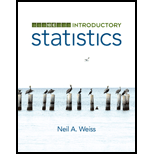
Concept explainers
For a linear equation y = b0 + b1x1 + b2x2 + b3x3, identify the
- a. independent variables.
- b. dependent variable.
- c. y-intercept.
- d. partial slopes.
a.
Identify the independent variables in the linear equation
Answer to Problem 1RP
The independent variables in the linear equation
Explanation of Solution
Justification:
Independent variable:
An independent variable in the multiple regression analysis is the variable which explains the variation in the response variable and which itself does not depend on any other variables in the regression. The predictor variables are the independent variables.
In the linear equation
Thus, the independent variables in the linear equation
b.
Identify the dependent variable in the linear equation
Answer to Problem 1RP
The dependent variable in the linear equation
Explanation of Solution
Justification:
Dependent variable:
A dependent variable in the multiple regression analysis is the variable the variation in which is explained by the predictor variables. The response variable is the dependent variable.
In the linear equation
Thus, the independent variables in the linear equation
c.
Identify the y-intercept in the linear equation
Answer to Problem 1RP
The y-intercept in the linear equation
Explanation of Solution
Justification:
The y-intercept:
The y-intercept in a multiple linear regression equation is the value taken by the response variable y, when all the predictor variables take value 0. The y-intercept gives the value of y at the point where the plane intersects the y-axis.
In a linear equation of the form,
Thus, the y-intercept in the linear equation
d.
Identify the partial slopes in the linear equation
Answer to Problem 1RP
The partial slopes in the linear equation
Explanation of Solution
Justification:
Partial slope:
The partial slope corresponding to a predictor variable in a multiple linear regression equation is a measure of the steepness of the plane along the direction of that predictor variable. The partial slope is the change in the response variable y, when the particular predictor variable increases by one unit, keeping all other predictor variables fixed.
In a linear equation of the form,
Thus, the partial slopes in the linear equation
Want to see more full solutions like this?
Chapter A Solutions
Introductory Statistics (10th Edition)
- Given your fitted regression line, what would be the residual for snake #5 (10 C)?arrow_forwardCalculate the 95% confidence interval around your estimate of r using Fisher’s z-transformation. In your final answer, make sure to back-transform to the original units.arrow_forwardCalculate Pearson’s correlation coefficient (r) between temperature and heart rate.arrow_forward
- A researcher wishes to estimate, with 90% confidence, the population proportion of adults who support labeling legislation for genetically modified organisms (GMOs). Her estimate must be accurate within 4% of the true proportion. (a) No preliminary estimate is available. Find the minimum sample size needed. (b) Find the minimum sample size needed, using a prior study that found that 65% of the respondents said they support labeling legislation for GMOs. (c) Compare the results from parts (a) and (b). ... (a) What is the minimum sample size needed assuming that no prior information is available? n = (Round up to the nearest whole number as needed.)arrow_forwardThe table available below shows the costs per mile (in cents) for a sample of automobiles. At a = 0.05, can you conclude that at least one mean cost per mile is different from the others? Click on the icon to view the data table. Let Hss, HMS, HLS, Hsuv and Hмy represent the mean costs per mile for small sedans, medium sedans, large sedans, SUV 4WDs, and minivans respectively. What are the hypotheses for this test? OA. Ho: Not all the means are equal. Ha Hss HMS HLS HSUV HMV B. Ho Hss HMS HLS HSUV = μMV Ha: Hss *HMS *HLS*HSUV * HMV C. Ho Hss HMS HLS HSUV =μMV = = H: Not all the means are equal. D. Ho Hss HMS HLS HSUV HMV Ha Hss HMS HLS =HSUV = HMVarrow_forwardQuestion: A company launches two different marketing campaigns to promote the same product in two different regions. After one month, the company collects the sales data (in units sold) from both regions to compare the effectiveness of the campaigns. The company wants to determine whether there is a significant difference in the mean sales between the two regions. Perform a two sample T-test You can provide your answer by inserting a text box and the answer must include: Null hypothesis, Alternative hypothesis, Show answer (output table/summary table), and Conclusion based on the P value. (2 points = 0.5 x 4 Answers) Each of these is worth 0.5 points. However, showing the calculation is must. If calculation is missing, the whole answer won't get any credit.arrow_forward
 Elementary AlgebraAlgebraISBN:9780998625713Author:Lynn Marecek, MaryAnne Anthony-SmithPublisher:OpenStax - Rice University
Elementary AlgebraAlgebraISBN:9780998625713Author:Lynn Marecek, MaryAnne Anthony-SmithPublisher:OpenStax - Rice University Algebra: Structure And Method, Book 1AlgebraISBN:9780395977224Author:Richard G. Brown, Mary P. Dolciani, Robert H. Sorgenfrey, William L. ColePublisher:McDougal Littell
Algebra: Structure And Method, Book 1AlgebraISBN:9780395977224Author:Richard G. Brown, Mary P. Dolciani, Robert H. Sorgenfrey, William L. ColePublisher:McDougal Littell Big Ideas Math A Bridge To Success Algebra 1: Stu...AlgebraISBN:9781680331141Author:HOUGHTON MIFFLIN HARCOURTPublisher:Houghton Mifflin Harcourt
Big Ideas Math A Bridge To Success Algebra 1: Stu...AlgebraISBN:9781680331141Author:HOUGHTON MIFFLIN HARCOURTPublisher:Houghton Mifflin Harcourt College Algebra (MindTap Course List)AlgebraISBN:9781305652231Author:R. David Gustafson, Jeff HughesPublisher:Cengage Learning
College Algebra (MindTap Course List)AlgebraISBN:9781305652231Author:R. David Gustafson, Jeff HughesPublisher:Cengage Learning Glencoe Algebra 1, Student Edition, 9780079039897...AlgebraISBN:9780079039897Author:CarterPublisher:McGraw Hill
Glencoe Algebra 1, Student Edition, 9780079039897...AlgebraISBN:9780079039897Author:CarterPublisher:McGraw Hill





